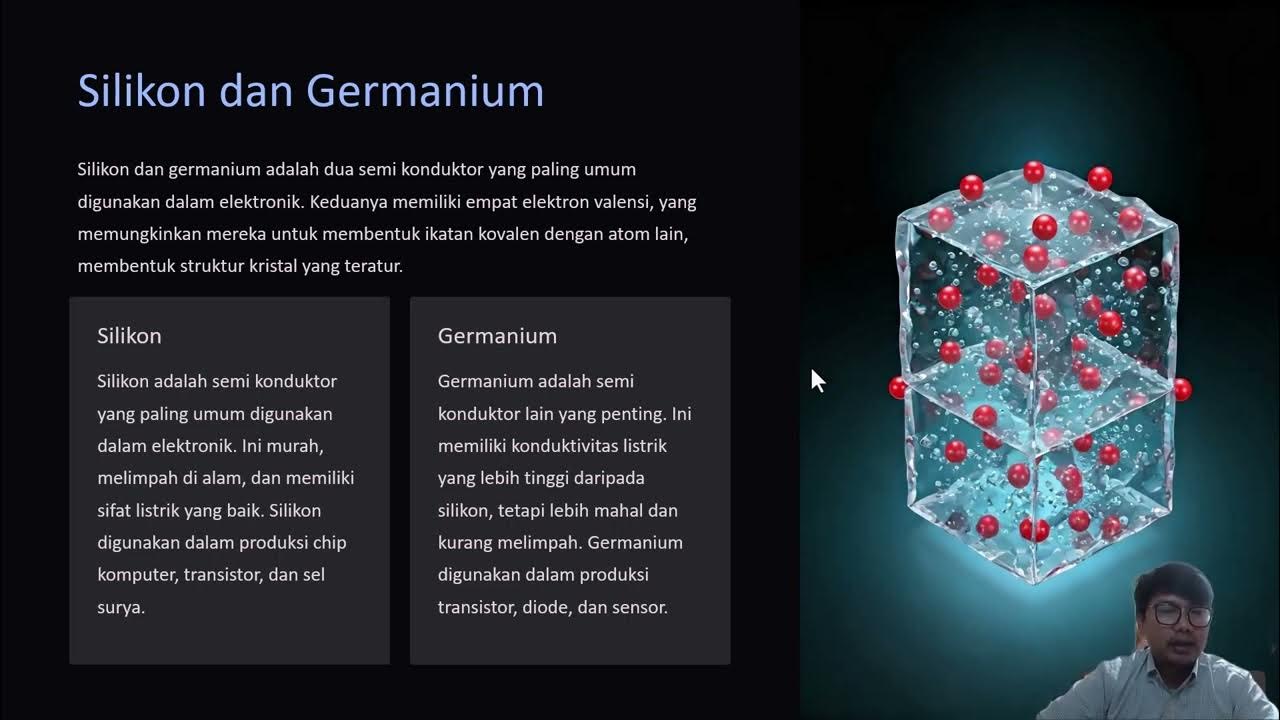Semiconductors, Insulators & Conductors, Basic Introduction, N type vs P type Semiconductor
Summary
TLDRThis video introduces semiconductors, explaining their properties as materials with conductivity between insulators and conductors. It covers how temperature and doping with impurities like phosphorus (for n-type semiconductors) or aluminum (for p-type semiconductors) can alter their conductivity. The concept of p-n junctions, which are critical for devices like diodes, transistors, and solar cells, is also explained, including how the movement of electrons and holes across the junction creates an electric field. The video provides a basic yet insightful overview of semiconductor behavior, electrical conductivity, and their applications in electronics.
Takeaways
- 😀 Semiconductors have properties between insulators and conductors. They conduct electricity better than insulators but not as well as conductors.
- 😀 Insulators, like sulfur and iodine, do not conduct electricity and have high resistance to electrical flow.
- 😀 Conductors, such as copper and aluminum, are excellent at conducting electricity, especially at lower temperatures.
- 😀 Semiconductors like silicon and germanium conduct a small amount of electricity and can have their conductivity adjusted.
- 😀 The conductivity of semiconductors increases with temperature, unlike metals, whose conductivity decreases with temperature.
- 😀 Doping semiconductors with impurities can change their conductivity. Adding elements with more or fewer valence electrons alters their properties.
- 😀 Silicon atoms have four valence electrons and form covalent bonds with other silicon atoms, creating a crystal structure.
- 😀 When silicon is doped with phosphorus (which has five valence electrons), it forms an n-type semiconductor, where the extra electron increases conductivity.
- 😀 Doping silicon with an element like aluminum (which has three valence electrons) creates a p-type semiconductor with 'holes' that conduct electricity.
- 😀 A p-n junction forms when n-type and p-type materials are combined. Electrons move to fill holes, creating a charge imbalance and an electric field.
- 😀 The p-n junction is the basis for electronic devices like diodes, which only allow electricity to flow in one direction when connected properly.
Q & A
What is the definition of a semiconductor?
-A semiconductor is a material that has properties between those of an insulator and a conductor. It conducts electricity to a limited extent, unlike conductors which allow electricity to pass freely.
How do insulators and conductors differ in terms of electrical conductivity?
-Insulators have very high resistance to electricity and do not conduct electricity at all. Conductors, like metals, allow electricity to pass freely and are excellent at conducting electricity.
What role does temperature play in the conductivity of semiconductors and metals?
-For semiconductors, increasing the temperature increases electrical conductivity. In contrast, metals have decreased conductivity as the temperature increases.
What is doping in the context of semiconductors?
-Doping involves adding impurities to a semiconductor to modify its electrical properties. This can be done by introducing atoms with different numbers of valence electrons, thereby increasing conductivity.
What happens when silicon is doped with phosphorus?
-When silicon is doped with phosphorus, which has five valence electrons, an extra electron is left over after bonding with silicon atoms. This extra electron increases the conductivity of the silicon, creating an n-type semiconductor.
What is an n-type semiconductor, and what are its charge carriers?
-An n-type semiconductor is a type of semiconductor created by doping with elements like phosphorus, which have five valence electrons. The charge carriers in an n-type semiconductor are electrons.
How does doping with aluminum create a p-type semiconductor?
-When silicon is doped with aluminum, which has three valence electrons, a 'hole' is created because aluminum can't form enough bonds with silicon, leaving a vacancy for an electron. This creates a p-type semiconductor, where the charge carriers are holes.
What is the difference between charge carriers in n-type and p-type semiconductors?
-In n-type semiconductors, the charge carriers are electrons, which move freely to conduct electricity. In p-type semiconductors, the charge carriers are holes, or electron vacancies, that move and contribute to electrical conduction.
What is a p-n junction, and how is it formed?
-A p-n junction is created when a p-type semiconductor and an n-type semiconductor are brought together. At the junction, electrons from the n-type region move to fill holes in the p-type region, creating an area with a buildup of negative charge on one side and positive charge on the other.
How does the electric field across a p-n junction affect electron movement?
-The electric field generated across the p-n junction makes it difficult for new electrons to cross from the n-type region to the p-type region. This creates a barrier, leading to the formation of a diode, which allows current to flow in only one direction.
Outlines

This section is available to paid users only. Please upgrade to access this part.
Upgrade NowMindmap

This section is available to paid users only. Please upgrade to access this part.
Upgrade NowKeywords

This section is available to paid users only. Please upgrade to access this part.
Upgrade NowHighlights

This section is available to paid users only. Please upgrade to access this part.
Upgrade NowTranscripts

This section is available to paid users only. Please upgrade to access this part.
Upgrade Now5.0 / 5 (0 votes)





